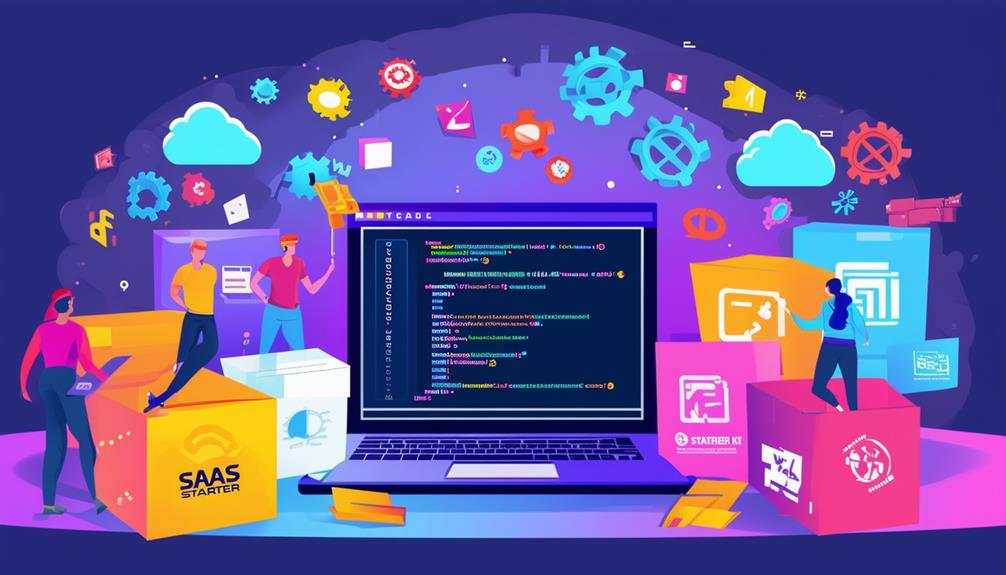When you consider developing a SaaS application, you might wonder how to streamline the process without sacrificing quality. A SaaS boilerplate serves as a pre-built framework that not only speeds up your development time but also helps you avoid common pitfalls. By providing essential features like user authentication and database integration, it allows you to focus on what truly sets your application apart. But what are the specific benefits that make using a boilerplate a strategic choice? Let’s explore the key advantages that could transform your approach.
Definition of SaaS Boilerplate
A SaaS boilerplate is a pre-built framework that streamlines the development of software-as-a-service applications, saving you time and effort. By providing a foundation that includes essential features and components, it allows you to focus on building the unique aspects of your application instead of starting from scratch.
Typically, a SaaS boilerplate includes user authentication, database integration, and basic user interface elements, ensuring you have a solid base to work from. It’s designed to handle common tasks and functionalities, which accelerates your development process and reduces potential errors.
You’ll find various boilerplates tailored to different programming languages and frameworks, making it easier to choose one that aligns with your project needs. By using a SaaS boilerplate, you can also benefit from best practices in coding, security, and scalability, which are already integrated into the framework.
Ultimately, adopting a SaaS boilerplate empowers you to launch your application faster while maintaining quality and efficiency. With less time spent on repetitive tasks, you can invest more energy into innovating and enhancing your software’s unique features, setting you up for success.
Key Benefits of Using Boilerplates
Using a SaaS boilerplate brings numerous advantages that can considerably enhance your development process and overall efficiency.
First, it provides a standardized structure, allowing you to focus on building unique features instead of reinventing the wheel. This means you can quickly implement common functionalities like user authentication, payment processing, and data management with minimal effort.
Additionally, boilerplates often include best practices and design patterns, ensuring your codebase is reliable and maintainable. This not only improves your software’s quality but also makes it easier for new team members to understand and contribute to the project.
Moreover, using a boilerplate can considerably reduce onboarding time for developers. Since the architecture is already laid out, they can dive right into coding without grappling with the foundational setup.
Lastly, by leveraging a SaaS boilerplate, you can stay ahead of the competition. It allows you to adapt to market needs more rapidly, as your core product is built on a solid foundation.
Accelerating Development Time
SaaS boilerplates greatly cut down development time, allowing you to launch your product faster and respond to user feedback without delays. By providing a solid foundation, these boilerplates eliminate the need for repetitive coding tasks, letting you focus on the unique features that set your service apart. You won’t waste time reinventing the wheel; instead, you’ll leverage pre-built components and frameworks that are already optimized for performance and scalability.
With a boilerplate, you can quickly set up essential functionalities like user authentication, payment processing, and database management. This streamlined approach accelerates your development cycle, enabling you to iterate and improve your product based on real user insights. You can prioritize feature development and design, knowing that the underlying architecture is robust and reliable.
Additionally, you can onboard new team members more efficiently. Since boilerplates come with standardized code and documentation, your team can get up to speed quickly, reducing the learning curve.
Ultimately, using a SaaS boilerplate means you can launch sooner, adapt faster, and stay ahead of the competition—all while maintaining high-quality standards.
Reducing Technical Debt
By streamlining development processes, a SaaS boilerplate greatly reduces technical debt, allowing you to maintain a cleaner codebase as your product evolves. This reduction in technical debt comes from the boilerplate’s ability to provide a solid foundation, enabling you to focus on building features rather than fixing underlying issues.
When you leverage a SaaS boilerplate, you’re adopting a pre-built structure that incorporates best coding practices and design patterns. This means you’re less likely to introduce bugs or create unnecessary complexity, which can lead to future headaches. Instead of reinventing the wheel, you can tap into established solutions that are already optimized for performance.
Moreover, using a boilerplate helps standardize your code across different teams and projects. This consistency makes it easier to onboard new developers and minimizes the chances of miscommunication. As your product grows, a well-structured codebase simplifies maintenance and updates, reducing the risk of accumulating technical debt.
In essence, a SaaS boilerplate not only accelerates development but also safeguards your project against the pitfalls of technical debt, paving the way for long-term sustainability and success.
Ensuring Best Practices
A well-designed boilerplate sets the stage for adhering to coding best practices, guaranteeing your team consistently delivers high-quality software. When you leverage a SaaS boilerplate, you gain a foundation built on proven methodologies, which helps you streamline your development process. This structure promotes uniformity across your codebase, making it easier for team members to understand and contribute effectively.
By implementing a boilerplate, you can enforce standards like code formatting, naming conventions, and documentation practices. This not only boosts maintainability but also reduces the risk of introducing bugs as you scale your application. It encourages collaboration, as developers can quickly familiarize themselves with the existing code, enhancing overall productivity.
Moreover, using a boilerplate allows you to integrate essential tools and libraries that support best practices, such as testing frameworks and security measures. This proactive approach guarantees your software remains robust and secure from the outset.
Ultimately, a well-crafted SaaS boilerplate empowers your team to focus on building features rather than worrying about foundational code, leading to higher quality outputs and a more efficient development cycle.
Customization and Scalability
Customization and scalability are crucial considerations when choosing a boilerplate, as they guarantee your application can evolve with your growing business needs.
When you select a SaaS boilerplate, you want to verify it allows you to tailor features and functionalities to meet your specific requirements. A customizable boilerplate empowers you to modify UI components, integrate third-party services, and adjust workflows without starting from scratch.
Scalability is equally important. As your user base expands, your application must handle increased traffic and data loads seamlessly. A scalable boilerplate enables you to add new features, improve performance, and support more users without compromising quality.
Look for a boilerplate that’s built on a robust architecture, allowing you to scale horizontally or vertically as needed. This adaptability guarantees your application remains responsive and efficient, no matter how much it grows.
Cost-Effectiveness in Development
Choosing a SaaS boilerplate that balances customization and scalability can also lead to considerable cost savings during development.
By leveraging pre-built components and functionalities, you can drastically reduce the amount of time and resources needed to get your project off the ground. This means you won’t have to reinvent the wheel for every feature, allowing your team to focus on what truly matters: delivering value to your users.
Additionally, using a boilerplate minimizes the risks associated with development. When you rely on established frameworks, you benefit from tested code and architectures, which can reduce bugs and technical debt. This not only saves you money on debugging and maintenance but also shortens your time to market.
Moreover, since you’re working with a solid foundation, you can allocate more of your budget to marketing and user acquisition instead of development costs. This shift can considerably improve your return on investment.
Ultimately, a well-chosen SaaS boilerplate not only streamlines your development process but also enhances your financial efficiency, allowing you to allocate resources where they matter most.
Facilitating Collaboration
Facilitating collaboration within your development team becomes much smoother with a well-structured SaaS boilerplate. By providing a common framework, everyone can work from the same set of guidelines and practices. This consistency not only streamlines development processes but also reduces the time spent on onboarding new team members.
When you use a boilerplate, it creates a shared understanding of the project’s architecture, coding standards, and best practices. This shared knowledge base minimizes misunderstandings and miscommunications, allowing your team to focus on building features rather than getting bogged down by technical discrepancies.
Additionally, a boilerplate often includes pre-configured integrations and tools, enabling seamless collaboration between frontend and backend developers. You can easily set up version control systems and continuous integration pipelines that enhance teamwork and guarantee that everyone is on the same page.
In the end, a SaaS boilerplate not only accelerates your development timeline but also fosters a collaborative environment where ideas can flow freely. By leveraging these structured tools, you empower your team to innovate and deliver high-quality products more efficiently.
Examples of Popular Boilerplates
Exploring popular SaaS boilerplates can give you a better understanding of how different frameworks can enhance your development workflow and collaboration.
One notable example is Blitz.js, which combines the power of React with a full-stack framework, allowing you to build applications quickly while maintaining a solid structure.
Another popular choice is Next.js, known for its server-side rendering capabilities and API routes, making it ideal for dynamic applications. If you’re looking for something more extensive, check out Meteor. It offers an integrated environment, complete with real-time data updates, which is perfect for collaborative apps.
Laravel is another robust option, especially if you prefer PHP. It provides a rich set of features that streamline the development process, including built-in authentication and routing.
Lastly, consider Ruby on Rails, which emphasizes convention over configuration, making it easier to jump into development without getting bogged down in setup.
Each of these boilerplates provides unique advantages, so choose one that aligns with your project needs and goals to maximize your efficiency and effectiveness.
To Wrap Up
In summary, using a SaaS boilerplate can greatly enhance your development process.
It accelerates your project timeline, reduces technical debt, and guarantees you’re following best practices.
With built-in customization and scalability, you can tailor your application to fit your needs while keeping costs down.
Plus, it fosters collaboration among your team, making it easier to launch high-quality software.
Embracing a boilerplate is a smart move for any developer looking to streamline their SaaS application development.






